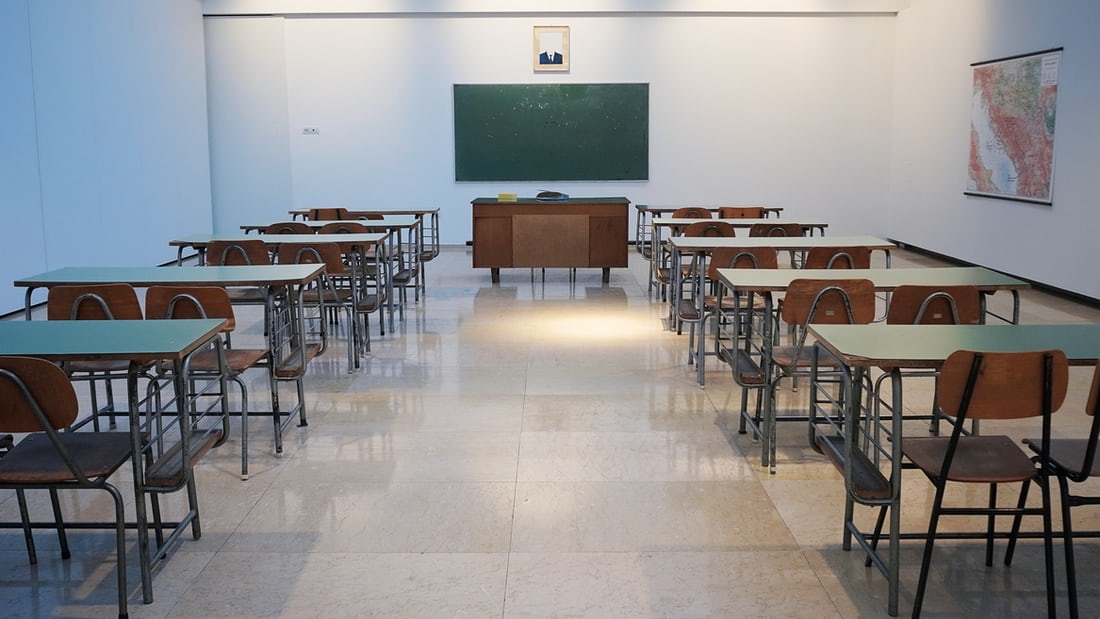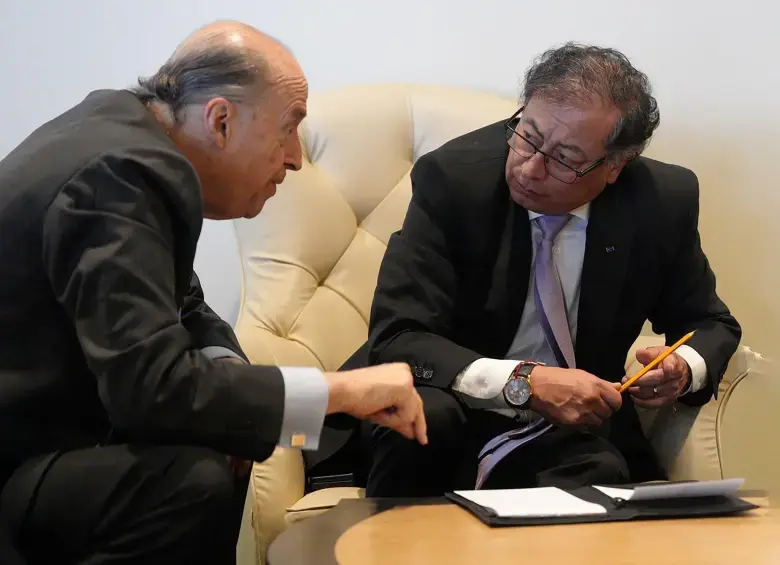In our new series focusing on the runup to the local elections, we’re looking at the biggest issues that whoever wins the race will have to tackle. We start with transport in Bogotá, an ongoing headache for all residents of la nevera.
“Decision-makers: the people in the city administration; the editors of newspapers, radio and TV; the politicians, all of them are in cars, so they view mobility as cars, not as people. And cars have been sold as giving you freedom, security, safety and respect.”
Dario hidalgo, expert on transport in bogotá
Transport in Bogotá is at best a contentious issue. It’s absolutely farcical that a capital city metropolis of 8 million odd relies on Bus Rapid Transport (BRT) as a primary (and only) mass transportation system, the TransMi. Worse still, the TransMilenio is ridden with avoidable problems. After that, it’s yet more buses for mass transit and little else.
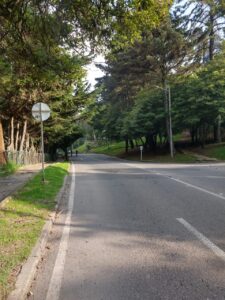
This means there is lots of motorised traffic bustling about, including armies of taxis and ride-sharing vehicles. In recent years motorbikes have exploded in numbers, bringing a sharp decline in road safety. On paper, the city has a strong cycling culture and an extensive bike lane network. There is also a tourist train, but that has no impact on transport in Bogotá. This means localism, and the capital is largely a 15-minute city, other than the work commute.
Transport in Bogotá is surprisingly car-dominated for a city where only 15% of people use a car regularly. Parking is widely available while illegal and antisocial parking is frequently ignored. Roads cut through everywhere, including the ciclovía and the otherwise green and lovely parks. Motorways run through the heart of the city and pedestrians are forced onto bridges or into tunnels, which are often few and far between.
An expert on transport in Bogotá
This is because many of the people in charge are overly focused on cars. As transport expert and professor at the Javeriana University, Darío Hidalgo, explained when we spoke to him. “Decision-makers: the people in the city administration; the editors of newspapers, radio and TV; the politicians, all of them are in cars, so they view mobility as cars, not as people. And cars have been sold as giving you freedom, security, safety and respect.”
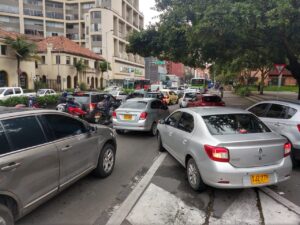
Hidalgo was originally the director of former mayor Enrique Peñalosa’s metro project. When that was abandoned, he became deputy GM of the TransMilenio and was involved in its implementation. “The priority,” he explains, “of mobility in Bogotá has always been public transportation. There is a non-written agreement that this is the bread and butter of transport in Bogotá.”
“For all of my professional life,” he emphasises, “I have believed that we need both a metro and TransMilenio. BRT has never been the only answer, because Bogotá has some heavy usage corridors that require a metro, although I realise it’s high cost and needs support from the national government.” That, of course, is where the problems start.
Politicisation and polarisation
Hidalgo highlights a key problem with mass transport in Bogotá, particularly appropriate in an election year: It’s become too mixed up with individual politicians. “Unfortunately, BRT and the metro became identified with political figures,” he said. “The BRT is Peñalosa, that was his creation when he was mayor from ‘98 to 2000. It became his brand, not the city’s and that was unfortunate because for many people BRT is bad, because it’s Peñalosa’s project.”

On the other hand he says the metro has been framed as a “leftist project, bringing you clean, green transport.” This started with the even more toxic Samuel Moreno, who promised it when he ran in 2005, then becoming identified with current President of Colombia Gustavo Petro and current Mayor of Bogotá Claudia López.
“In his campaign, he talked about bus corridors,” Hidalgo says of Petro. “But once in office he continued the plan for the metro and came out at the end of his term with a plan that cost twice the previous project but still had support from president Santos.” Time ran out though, and Peñalosa changed the project back again when he became mayor again.
On the buses
The TransMilenio would be an excellent secondary service for transport in Bogotá. However, as a primary, it’s woefully inadequate at peak hours. It can be a pleasure to use off-peak, but quickly falls apart under pressure. This shouldn’t be a surprise, with two million trips being taken per day. There are another two million trips on the regular bus network as well.
The system is run by SITP, a public-private partnership which also handles those smaller buses. The integration of those services and the TransMilenio expansion saw costs spiral. Hidalgo says there is “A growing deficit which is now three trillion peso [USD$700 million]. It’s a lot of money every year for us and it was not the case ten years ago. The fare was covering everything and breaking even.”
Whoever ends up on the Iron Throne in the Palacio Liévano will have a hard job keeping the organisation in the black. Fare increases will not be popular, nor will cutting less profitable lines. For now, it’s covered by the national government which Hidalgo says is, “Good but not great.” He continues, “You cover the deficit and keep running the service but you need to manage it better – reduce costs, improve quality of service, improve safety.” Easier said than done, of course.
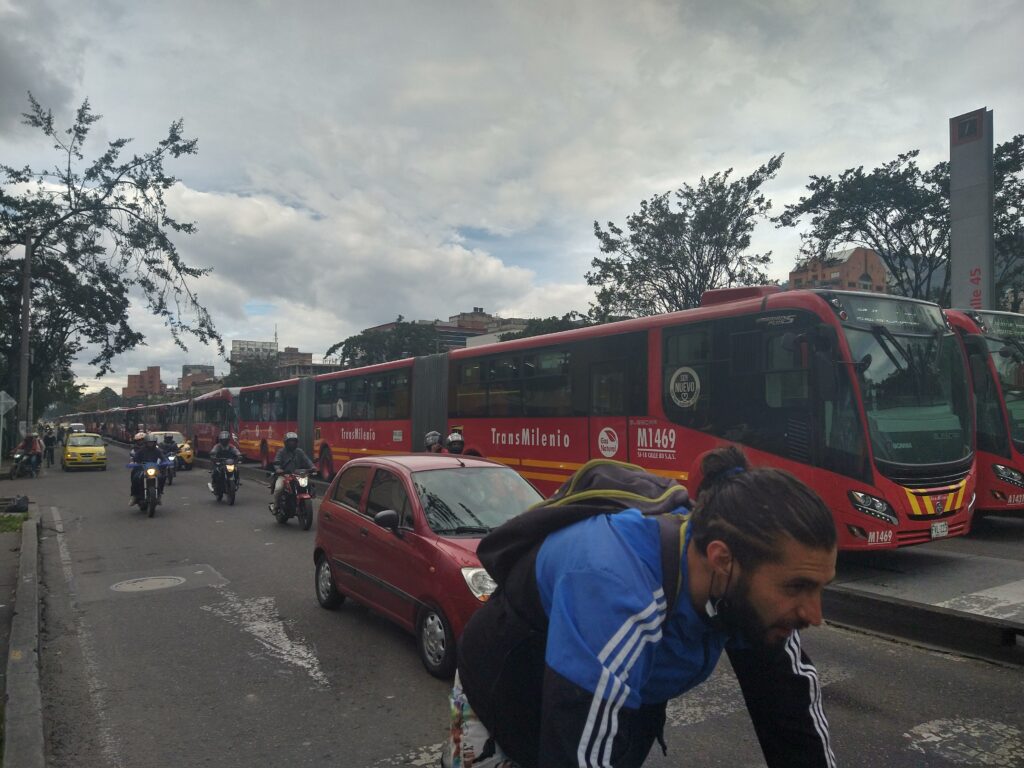
Security has long been a bone of contention for residents of the city, and that applies to the system of mass transport in Bogotá as much as anywhere else. Robberies on the system are frequent and there was a recent death as a woman fell from a train when pursuing a robber. Another attempt at mass robbery recently ended up in a shootout with police. Feminist groups have long complained about the levels of sexual assault and groping on the system.
Then there is the problem of fare evasion, which has provided dramatic videos of buses being stormed. Some stations have seen increased barriers to entry such as extra doors, tighter turnstiles, spiked fences and so on, yet fare-dodgers still jump over these with ease while paying passengers are inconvenienced. They’re known as colados locally, and are a common sight, provoking widespread anger. Can they be tackled?
“I don’t have a magic wand,” says Hidalgo. “I know [safety and fare evasion] are very big problems – they go beyond the transport system and reflect a society where stealing is cool. I think there should be a big investment in cracking down on colados, for two reasons. It’s unacceptable to have so many people not paying for the service they are receiving. The second reason is that we will receive more money. But I must say, it is difficult. You need police everywhere. ”
Partly, the design is bad: There is no monthly discount as in most big transport systems, simply a flat single-use fee. “That’s a very unfortunate legacy that has not been solved,” says Hidalgo. “No multi-pass option, no discounts and I don’t really know why. The fare is very high for some people. It’s 12% of the minimum wage, so let’s help them. But a low fare for everyone isn’t necessary. Petro created a subsidy system (based on SISBEN) which I think works. There’s some abuse, but it’s not too bad.”
It seems to be a point of principle for SITP to not provide information for users at point of use, solely by app. For example, bus stops often only show the routes they service on the outside-facing side, so when you stand at the stop you can’t see what may be arriving. The signs telling you which stops a Transmi runs to are often damaged or ripped down as they have no protection inside the station.
The fabled metro
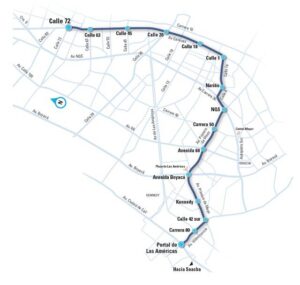
The much-delayed metro project which will revolutionise transport in Bogotá is now under construction. Hidalgo says, “I’m happy that at last the metro is being built. It is so important for the city. I would have preferred that the metro was contracted underground in the first place but that was not the decision made by the people who got the funding, which I understand. Especially near to the mountains where it is most needed, it’s about twice as expensive.”
The main sticking point has been the intense political polarisation of the project. Now he is president, Petro has stuck his oar in again and demanded it be underground. Hidalgo notes that the president calls the underground metro ‘digno’ or worthy whereas the elevated metro is ‘corrupt.’ “That’s the level of the political debate,” he tells me. “It’s not timely, the project is underway and has been contracted. It’s starting to build. Any change at this moment will mean more cost and more delays. Is that justified? Minister William Camargo thinks it is. I’m really frustrated.”
The main complaint about the metro from most people on the streets relates directly to that: It doesn’t exist yet. Somewhat insultingly, the local government has set up a ‘metro school’ where you can visit a carriage and learn how to use a train. Rolos are not idiots though, and are as capable as anyone else at entering a carriage. The problems with transport in Bogotá stem from underlying issues such as time hassles rather than a lack of knowledge.
One line is planned at first for the metro, with another going out to contract. This would still be ting compared to comparable cities. Hidalgo estimates that a proper system of mass transport in Bogotá would need “5-6 [similarly sized to the first] lines to be constructed over the next 50 years. It’s impossible to build it faster, the real limitation is funding.”
In the coming elections, an underground metro is supported by Gustavo Bolívar and Rodrigo Lara. All the other candidates say they will continue with the pre-contracted plans. Hidalgo observes that any winner “Is not going to start the operation [of services] because that is 2028. They will build it and have all the city under construction but not see success.”
A train that is on the rails to success
A related project that suffers far less political infighting is the RegioTram which is on track both literally and figuratively. Improving transport in Bogotá and to her satellite towns will be a real game-changer and seems to be progressing nicely. While it is way beyond the original estimation of operation in 2024, it does look like it will happen.
Hidalgo says that, “More recently Bogotá is expanding to the West, Puente Aranda, Fontibón. And the towns outside Bogotá are growing really fast along that corridor too. Mosquera, Funza, Madrid, that’s where the growth is. Towers, commerce and industry everywhere, not so much in the city anymore.”
Corredor Verde – seventh time’s a charm?
The current plan for sorting out congestion on the Séptima is the seventh attempt to do so. It consists of bicycle lanes and a new TransMilenio route. Mini Transmilenios already run on the Séptima. Until now, every plan has fallen apart in the face of fierce NIMBYism. Bizarrely, this is an attempt by people to stop cleaner air in their own neighbourhood. The opposition to the corredor verde is entirely from local residents. Those that travel into the zone largely support it as a way to cut their commute time.
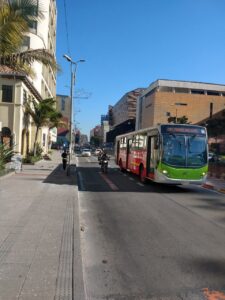
The candidates for mayor are refusing so far to back the project, which means it may not happen. Some are fence-sitting, others oppose it. Either way it will be a big early decision. It speaks to a wider problem with transport in Bogotá, which is that the areas where the work is aren’t where the workers are. Usaquén and Chapinero see a massive influx of movement everyday, with a corresponding outflow from the western and southern localidades. The project seeks to make it easier for mass transport to arrive in this heavily commercial area.
Hidalgo lives in the area yet supports the project. “I walk, bike and use the buses on Séptima, that’s how I arrive at the uni. So the project will bring great benefits to me personally. I am like most users of the corridor, I use the public transportation, not my car, because I don’t need to. From a transport planner’s perspective, we will have a better Séptima. We will have more greenery, which it lacks, although it will take time to grow. It will affect car drivers, but that’s only 8% of journeys in Chapinero. I don’t think it’s a big deal.”
Hidalgo hopes it will come to pass, saying that it has completed three conditions. “The designs are done, the funding is there and the current mayor is totally behind it.” Even so, it’s far from a done deal. “In the council there are two sides, ten out of 40 are against the project and the rest are quiet, that’s a problem,” he says. “Only one is in favour and he doesn’t have a strong voice. I think Claudia would like it as her legacy. It’s a different kind of TransMilenio, with better urban design.”
Get on your bike
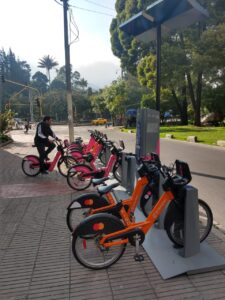
Bicycle paths under Claudia have been a successful part of her plan for transport in Bogotá, seeing good maintenance of existing routes as well as new ones in largely sensible places. Chief among these are the Calle 13 and Séptima routes, both of which follow routes cyclists naturally take and are heavily used. Despite a rocky implementation and some issues over placement, she’s got them done and deserves credit. The new mayor will likely continue that.
The erstwhile mayor has also overseen the successful Tembici bike sharing project. We gave it a cautious thumbs up after its launch last autumn, and most of our concerns from that time have now been addressed. There are more places to return and rent bikes, most of which are genuinely useful. Critically, it’s widely used – already passing the million-journey mark. Hidalgo agrees, saying he uses them all the time.
There’s always jam tomorrow
Traffic jams bedevil the city and are high on the complaint list when people discuss transport in Bogotá. Simply put, there are too many cars and not enough road. It’s not really feasible to build more road, so there should be a focus on cutting the number of cars. That’s politically awkward though, as noted earlier
Ridesharing systems and taxis mean a great number of vehicles circulating day-long. While these are better than personal cars as they make multiple journeys, they still contribute to high-traffic situations. Yellow taxis are disliked by many, with the ridesharing apps both cheaper and more trusted. These are largely unregulated though.
The regulated yellow taxis don’t help themselves, having fended off proposed regulations many times and provoking strong opinions on both sides. Schemes such as the día sin carro are widely praised by city planners and the like, as they massively help the majority of people. However, they face fierce opposition from vested interests, who are inevitably car enthusiasts.
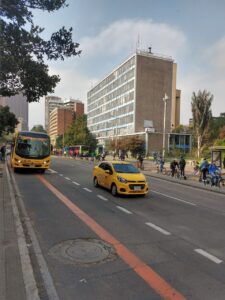
The ongoing jams have led to a jump in the number of moto and scooter users, as well as pushbikes with two-stroke engines powering them and essentially making them janky versions of mopeds. Rodrigo Lara has positioned himself as the hero of the motorbikers, promising to defend their rights. He sees a lot of votes there, and he’s likely right.
“Motos are here to stay,” confirms Hidalgo. “They are cheap, exciting and convenient in many ways. They are a growing community and support each other. At the same time, there are several issues, the worst being accidents and fatalities which is putting our numbers upside down; we were improving and now we are going backwards in terms of deaths and injuries. It’s especially young, new riders. We need stricter licensing and better controls. 40% of deaths are unlicensed riders.”

